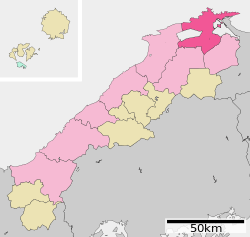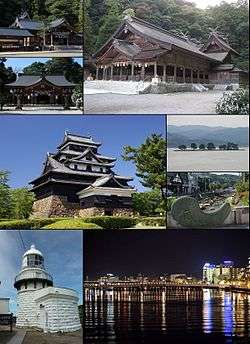Matsue
| Matsue 松江市 | ||
|---|---|---|
| Special city | ||
|
From top left: Kumano Taisha, Yaegaki Shrine, Miho Shrine, Matsue Castle, Lake Shinji (Yomegashima), Tamatsukuri hot springs, Mihonoseki Lighthouse, Night view of Matsue | ||
| ||
 Location of Matsue in Shimane Prefecture | ||
 Matsue Location in Japan | ||
| Coordinates: 35°28′N 133°3′E / 35.467°N 133.050°ECoordinates: 35°28′N 133°3′E / 35.467°N 133.050°E | ||
| Country | Japan | |
| Region | Chūgoku (San'in) | |
| Prefecture | Shimane Prefecture | |
| Government | ||
| • Mayor | Masataka Matsuura (since June 2000) | |
| Area | ||
| • Total | 530.21 km2 (204.72 sq mi) | |
| Population (April 30, 2011) | ||
| • Total | 191,852 | |
| • Density | 361.84/km2 (937.2/sq mi) | |
| Symbols | ||
| • Tree | Pinus, Cherry blossom | |
| • Flower | Camellia, Peony | |
| Time zone | Japan Standard Time (UTC+9) | |
| City hall address |
86 Suetsugu, Matsue-shi, Shimane-ken 690-8540 | |
| Website |
www | |
Matsue (松江市 Matsue-shi) is the capital city of Shimane Prefecture located in Chūgoku region of the main island of Honshu.[1][2] As of August, 2011, the city has an estimated population of 207,000, following its most recent merging with the town of Higashiizumo (from Yatsuka District).
Matsue sits between Lake Shinji and Nakaumi, along the banks of the Ohashi river connecting the two. The overall population of the Lake Shinji-Nakaumi area is approx 600,000, marking Matsue as the second major city on the sea of Japan coast after Niigata. Due to the prominence of the lakes, the river and canals in the city-scape and scenery it is sometimes called the "water city" (水の都). Nearby Izumo Taisha is recognized as one of the oldest Shinto shrines in Japan and is ranked second in importance only to Ise Grand Shrine in Mie Prefecture.
History
The present-day castle town of Matsue was originally established by Horio Yoshiharu, lord of the Matsue clan, when he built Matsue castle and planned the surrounding Castle town over a five-year period from 1607 to 1611. Matsue continued to be the seat of power in the Sanin Region for many years.
Matsue was first ruled by the Horio family. Horio Yoshiharu's son Tadauji died before his father, thus the province was inherited by his grandson Tadaharu. However, Tadaharu died childless so the province was passed on to the Kyogoku. The Kyogoku were daimyo from Omi and Wakasa. Kyogoku Takatsugu served Nobunaga and Hideyoshi. Takatsugu's son Tadataka married the 4th daughter of Hidetada, Hatsu. He served in the Battle of Osaka and reportedly took 300 heads. In 1634, he received the province of Izumo, succeeding the childless Horio Tadaharu. During his rule he was instrumental in engineering projects that helped control the flow of the Hiikawa river.
In 1637, Tadataka also died childless and the domain passed to the Matsudaira. Naomasa was the third son of Hideyasu. Hideyasu, daimyo of Echizen, himself was the second son of Tokugawa Ieyasu, making Naomasa the grandson of the first Tokugawa Shogun Ieyasu. Naomasa made a name for himself fighting in the Battle of Osaka at the age of 14. He was daimyo of Ono in Echizen and later Matsumoto in Shinano before becoming the ruler of Izumo 1638. Unlike the previous rulers Naomasa had children and his heirs managed to keep Izumo for ten generations until the end of the Edo Bakufu. Overall, ten Matsudaira Daimyo ruled from Matsue. The most famous after the first (Matsudaira Naomasa) was the seventh, Matsudaira Harusato. He revolutionized the administrative system of the Matsue clan which was in financial difficulties and put it back on its feet. He invested in Mulberry bushes and promoted special foods like clams that were a delicacy in Matsue. Harusato was a great enthusiast of Tea Ceremony. His Tea Ceremony name was Fumai. He founded his own school, Unshyu. He has left the Meimei-An a famous tea house still operating in Matsue. Because his influence on wagashi, Japanese sweets for Tea Ceremony from Matsue are famous, especially one called wakakusa.
The city boasts Matsue Castle, the "black castle" or "plover castle". It is one of the 12 remaining original castles in Japan. It is the second largest, the third tallest and the sixth oldest. The castle grounds include a winding path through mixed forests of bamboo, shrubs and trees, many of which are very old and identified by species. Surrounding the grounds and the castle park is the old moat, "horikawa".
Author Lafcadio Hearn taught in Matsue from 1890-1891. His house is now a museum about his life, and a popular tourist attraction in Matsue. Throughout the city there are monuments and landmarks honouring Hearn. Other museums in the city include the Shimane Art Museum and Tanabe Art Museum.
Sada Jinja in Matsue is the home to Sada Shin Noh, a sacred dance comprising a series of purification rituals related to the changing of the rush mats within the shrine. The mats are held by dancers who then offer them to deities to sit upon. Diverse dance forms are performed on a stage in the shrine accompanied by singing, flute and drums. The performance art is transmitted from generation to generation by the community. In November 2011, Sada Shin Noh was inscribed on the UNESCO Representative List of the Intangible Cultural Heritage of Humanity.[3] Other important shrines include Yaegaki Jinja, Kamosu Jinja, and Miho Jinja, and there are the ruins of Izumo Kokubunji, an Historic Site.[4]
Municipal timeline
- April 1, 1889: the original city of Matsue was founded.
- March 31, 2005: the original city of Matsue absorbed the towns of Kashima, Mihonoseki, Shimane, Shinji, Tamayu and Yatsuka, and the village of Yakumo, all from Yatsuka District, to create the new and expanded city of Matsue.
- August 1, 2011: the town of Higashiizumo (also from Yatsuka District) was merged into Matsue.[5]
Climate
Matsue has a humid subtropical climate (Köppen climate classification Cfa) with very warm summers and cool winters. Precipitation is abundant throughout the year, and is somewhat heavier in June, July and September.
| Climate data for Matsue, Shimane | |||||||||||||
|---|---|---|---|---|---|---|---|---|---|---|---|---|---|
| Month | Jan | Feb | Mar | Apr | May | Jun | Jul | Aug | Sep | Oct | Nov | Dec | Year |
| Average high °C (°F) | 7.3 (45.1) |
8.0 (46.4) |
11.8 (53.2) |
18.0 (64.4) |
22.5 (72.5) |
25.3 (77.5) |
29.4 (84.9) |
31.1 (88) |
26.4 (79.5) |
21.1 (70) |
15.8 (60.4) |
10.5 (50.9) |
18.93 (66.07) |
| Daily mean °C (°F) | 3.7 (38.7) |
4.0 (39.2) |
6.9 (44.4) |
12.5 (54.5) |
17.1 (62.8) |
20.9 (69.6) |
25.2 (77.4) |
26.5 (79.7) |
22.0 (71.6) |
16.1 (61) |
11.0 (51.8) |
6.4 (43.5) |
14.36 (57.85) |
| Average low °C (°F) | 0.5 (32.9) |
0.6 (33.1) |
2.5 (36.5) |
7.7 (45.9) |
12.4 (54.3) |
17.3 (63.1) |
22.1 (71.8) |
22.9 (73.2) |
18.5 (65.3) |
12.0 (53.6) |
6.9 (44.4) |
2.7 (36.9) |
10.51 (50.92) |
| Average precipitation mm (inches) | 151.1 (5.949) |
136.5 (5.374) |
126.8 (4.992) |
124.0 (4.882) |
119.6 (4.709) |
196.0 (7.717) |
268.3 (10.563) |
145.4 (5.724) |
216.3 (8.516) |
135.0 (5.315) |
137.8 (5.425) |
137.9 (5.429) |
1,894.7 (74.595) |
| Average snowfall cm (inches) | 46 (18.1) |
45 (17.7) |
9 (3.5) |
0 (0) |
0 (0) |
0 (0) |
0 (0) |
0 (0) |
0 (0) |
0 (0) |
0 (0) |
18 (7.1) |
118 (46.4) |
| Average relative humidity (%) | 76 | 76 | 74 | 73 | 74 | 80 | 82 | 79 | 81 | 79 | 79 | 77 | 77.5 |
| Mean monthly sunshine hours | 71.5 | 83.7 | 144.1 | 181.3 | 216.3 | 172.0 | 188.2 | 215.3 | 153.4 | 160.1 | 111.3 | 84.4 | 1,781.6 |
| Source: NOAA (1961-1990)[6] | |||||||||||||
Culture
Traditional festivals are still pursued, for example, the Matsue Dou drum parade. It is held annually on the third Sunday of October. It was originally a New Year's festival but has changed purpose over the years.
Education
Universities and colleges
- Shimane University
- Shimane Prefectural Women's College
- Matsue College of Technology
International relations
Friendship cities
-
 New Orleans, United States, 1990 (commenced)/1994 (official agreement)
New Orleans, United States, 1990 (commenced)/1994 (official agreement) -
 Jilin City, China, 1995 (commenced)/1999 (official agreement)
Jilin City, China, 1995 (commenced)/1999 (official agreement) -
 Dublin, Ireland
Dublin, Ireland -
 Chinju City, South Korea, 1999 (official agreement)
Chinju City, South Korea, 1999 (official agreement) -
 Hangzhou City, China, 1994 (commenced)/2003 (official agreement)
Hangzhou City, China, 1994 (commenced)/2003 (official agreement) -
 Yinchuan City, China, 1994 (commenced)/2004 (official agreement)
Yinchuan City, China, 1994 (commenced)/2004 (official agreement) -
 Onomichi, Hiroshima, 1994 (official agreement)
Onomichi, Hiroshima, 1994 (official agreement)
Sister cities
References
- ↑ Nussbaum, Louis-Frédéric. (2005). "Matsue" in Japan Encyclopedia, p. 617; "Chūgoku" at p. 127.
- ↑ Japan National Tourism Organization (JNTO), "Matsue area"; retrieved 2012-2-11.
- ↑ "Sada Shin Noh, sacred dancing at Sada shrine, Shimane". UNESCO. Retrieved 31 January 2012.
- ↑ "Izumo Kokunbunji". Agency for Cultural Affairs. Retrieved 31 January 2012.
- ↑ 松江市が人口「最下位」を返上 Sanin-Chūō Shimbun (Japanese)
- ↑ "Matsue Climate Normals 1961-1990". National Oceanic and Atmospheric Administration. Retrieved January 5, 2013.
External links
| Wikimedia Commons has media related to Matsue, Shimane. |
| Wikivoyage has a travel guide for Matsue. |


